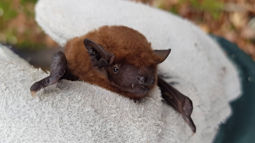For the first time ever, the Glencoe Greenway makes it possible for people to safely walk, wheel and cycle on a completely traffic-free route through the dramatic landscape.
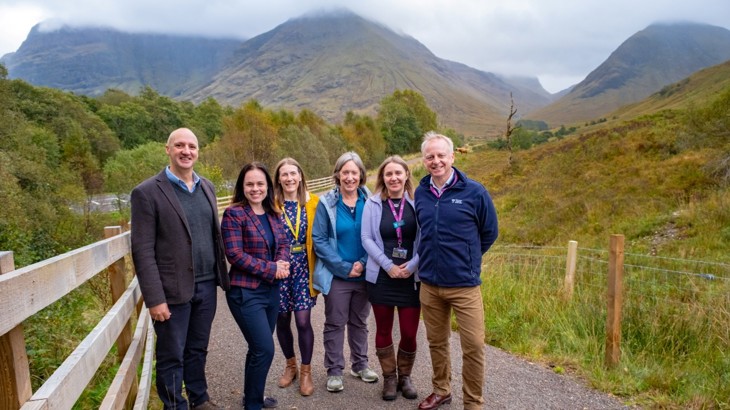
Not a bad backdrop. Local MSP Kate Forbes joins project partners to celebrate the opening of the Glencoe Greenway. Credit: Michael Kelly.
The Glencoe Greenway offers locals and visitors alike the chance to safely walk, wheel and cycle into the heart of the iconic glen from the west for the very first time.
Funded through our National Cycle Network Development programme and delivered in close partnership with National Trust for Scotland, the 5km route is now fully open to the public.
Reducing pressure on the glen whilst improving safety
For locals and for regular visitors, an intimate knowledge of the fast A82 trunk road goes hand in hand with the Glen Coe experience.
Connecting Glasgow with Inverness via Fort William, the road serves as a main artery for commercial and heavy goods vehicles.
At the same time, it gives passage to 2 million tourists each year, with close to a million stopping in the glen.
For those visiting in the height of season, the road doesn’t feel safe – burdened with lots of vehicles, limited parking, and often people walking on the grass verge.
Setting out to address these issues, the Glencoe Greenway project has created a dedicated path for walking, wheeling and cycling, away from the road.
This now provides a safe, accessible and attractive alternative to using a car.
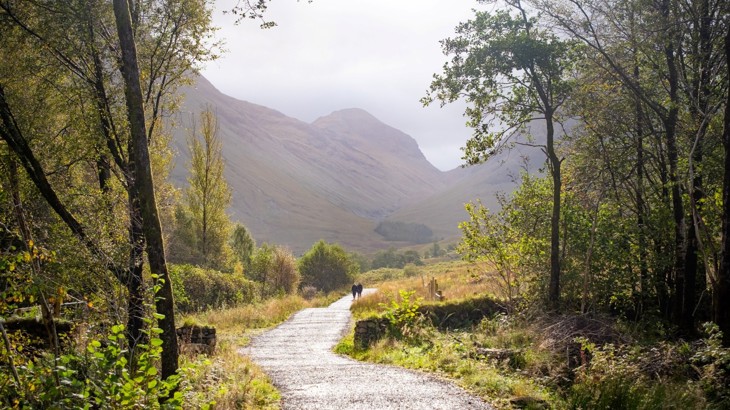
With sections of the Greenway open since winter, more than 16,500 people have already used the path - and counting. Credit: Michael Kelly.
Glencoe Greenway and beyond: a route guide
The Greenway is made up of 5km of new traffic-free, shared-use path – comprising 3km built from scratch and a 2km upgrade of existing pathways.
At 3 metres wide, the path is accessible for wheelchair users and buggies, and offers enough space for people walking, wheeling or cycling to pass each other safely.
Although removed from it, the path runs alongside the A82 trunk road, providing a direct route through the glen.
The route runs from Glencoe village to the National Trust for Scotland visitor centre and up the valley to the Clachaig Inn turn off.
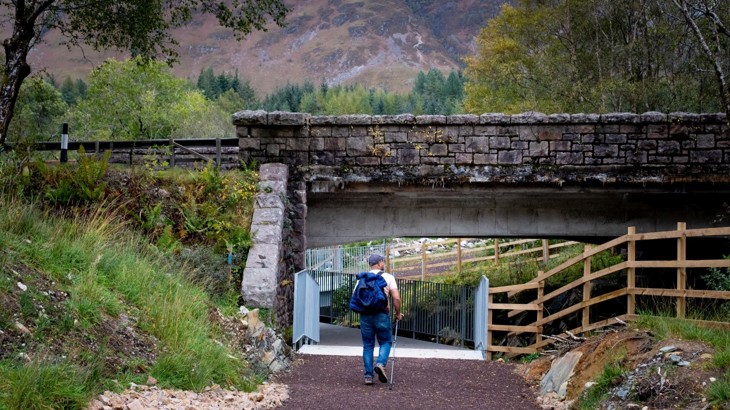
The final piece of the jigsaw was an underpass and bridge combo, crossing both the A82 and the river Coe. Credit: Michael Kelly.
By connecting to the quietway road from the Clachaig Inn back to the village, the Greenway completes the Glencoe Orbital Trail, a long-held community aspiration.
This loop is 10km in total and takes around an hour on an e-bike – longer when stopping to take in the various historic points of interest along the way, not to mention the local places to eat and drink.
At the village end, the route also connects onto National Cycle Network Route 78, otherwise known as the Caledonia Way.
This means that for those who wish to explore further afield, there is now a direct pedestrian and cycle route all the way from Glencoe to Oban and Fort William.
Looking to the future, additional improvements are to come including more seating and interpretation boards along the route that nod to the glen’s heritage and wildlife.
There are also aspirations to extend the Greenway up to the Three Sisters carpark.
This would connect the glen from west to east and provide a sustainable alternative for tourists to reach the car park, which is a key access point for the surrounding hills.
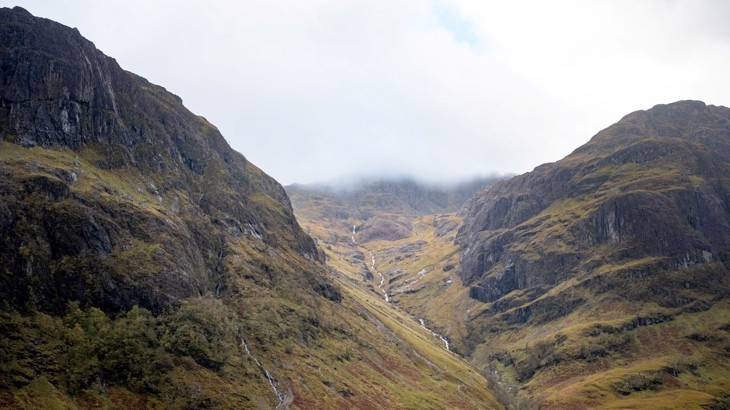
An ambition to extend the Greenway to the Three Sisters would connect the glen all the way from west to east. Credit: Michael Kelly.
Progression and conservation: striking the right balance
Reducing environmental impact was a key priority across the various aspects of the project.
Carving a new path through a precious national nature reserve was not a decision that was taken lightly.
Sensitive design and material choices have created a route that is respectful of the surrounding landscape and the natural life it’s home to.
The path has been designed to mirror the glen’s existing low-level path network, and is already blending into its surroundings well.
Construction itself was carried out by local contractors from Oban and Mallaig, and the design was led by local engineer Ian MacGillivray.
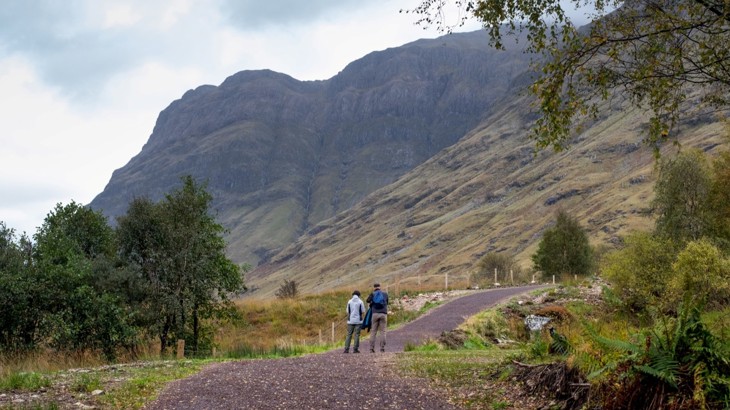
The Greenway was meticulously designed to minimise visual and ecological impact through the careful choice of route, materials, landscaping, and surface finish. Credit: Michael Kelly.
Active travel unlocks sustainable tourism
The Glencoe Greenway is a major step for sustainable tourism in the area.
Reducing cars is a win for local nature, for safety and for road maintenance.
And by making walking, wheeling and cycling a realistic and attractive option, we increase footfall to local businesses and help communities to thrive.
The Greenway itself is a new sustainable tourist attraction, offering a unique and enjoyable experience, as well as a way to get from A to B.
Now that the route is fully open, National Trust for Scotland will be working with local businesses to promote its use to visitors year-round.
But it's not only tourists who will benefit from these improvements.
The route is an asset for the local community, offering a fantastic loop for walkers, runners and cyclists – whilst experiencing the glen from a new perspective.
For families, the traffic-free path is the perfect spot for young children learning to cycle.
And for those who live nearby and work along the route, whether it be at the visitor centre or the Clachaig Inn, they now have an attractive alternative to driving to work.
This integration of tourism and community shows the role active travel can play in shaping thriving local places for everyone to enjoy, now and into the future.
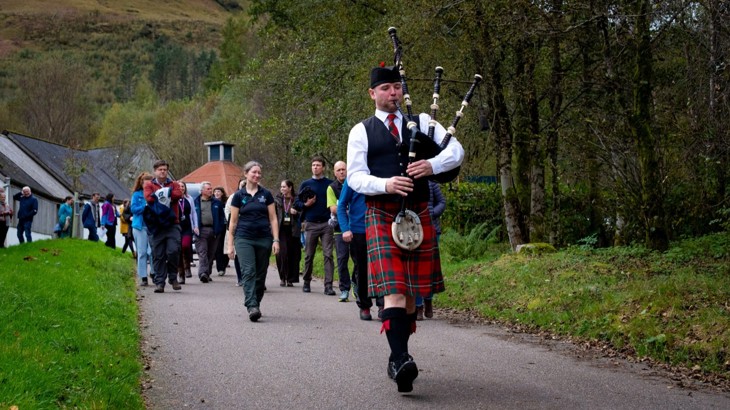
Did an opening event in the Highlands even happen if there wasn't a piper? Credit: Michael Kelly.
The Glencoe Greenway has been made possible by a partnership between Walk Wheel Cycle Trust and National Trust for Scotland, the custodian of Glencoe National Nature Reserve.
Funding of almost £2 million has come from the Scottish Government via Transport Scotland, administered through Walk Wheel Cycle Trust’s Network Development programme, and through the Rural Tourism Infrastructure Fund managed by VisitScotland.
National Trust for Scotland’s ranger team will now look after the path as part of a network of 65km in their care in the Glencoe National Nature Reserve.




